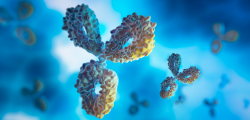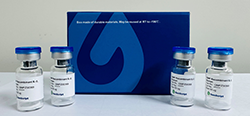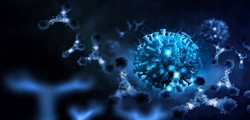| Specificity |
This product is specific for double-stranded RNA (dsRNA) with the length of the helix greater than or equal to 40 bp. The dsRNA-recognition is independent of the sequence and nucleotide composition of the antigen. |
| Host Species |
Mouse |
| Immunogen |
Double-stranded RNA |
| Conjugate |
Unconjugated |
|
Working concentrations for specific applications should be determined by the investigators. The appropriate concentrations may be affected by secondary antibody affinity, antigen concentration, the sensitivity of the method of detection, temperature, the length of the incubations, and other factors. The suitability of this antibody for applications other than those listed below has not been determined. The following concentration ranges are recommended starting points for this product. |
| Application |
Recommended Usage |
| ELISA |
Maria Bokarewa et al. (2008) Arthritogenic dsRNA is present in synovial fluid from rheumatoid arthritis patients with an erosive disease course. Eur J Immunol. Viruses. PMID: 31615058 |
| Dot Blot |
Dengwang Luo et al. (2019) Lateral flow immunoassay for rapid and sensitive detection of dsRNA contaminants in in vitro-transcribed mRNA products. PMID: 37181450 |
| Immunoprecipitation (IP) |
Matthew Hackbart et al. (2021) Coronavirus endoribonuclease targets viral polyuridine sequences to evade activating host sensors. PMID:32198201 |
| Immunocytochemistry/Immunofluorescence (ICC/IF) |
Matthew Hackbart et al. (2021) Coronavirus endoribonuclease targets viral polyuridine sequences to evade activating host sensors. PMID:32198201 |
|
| Form |
Lyophilized |
| Storage Buffer |
Lyophilized with PBS, pH 7.2, containing 0.02% sodium azide. |
| Reconstitution |
Reconstitute the lyophilized powder with deionized water (or equivalent) to a final concentration of 0.5 mg/mL. |
| Storage Instructions |
The lyophilized product remains stable up to 1 year at -20 °C from date of receipt. Upon reconstitution, it can be stored for 2-3 weeks at 2-8 °C or for up to 12 months at -20 °C or below. Avoid freeze/thaw cycles. |
| Purification |
Protein A affinity column |
| Isotype |
Mouse IgG2a, κ |
| Clonality |
Monoclonal |
| Clone ID |
K1 |
| Note |
GenScript can customize this product per customer's request including product size, buffer components, etc. |
| Target Background |
Double-stranded RNA (dsRNA) forms in nucleic acid strands containing complementary sequences. In gene therapy, minimization and removal of double-stranded RNA (dsRNA) is important for mRNA in vitro transcription (IVT) processes. Anti-dsRNA monoclonal antibody K1 recognizes dsRNA. When the J2 antibody did not provide nice results, the K1 antibody has been an alternative to reduce unwanted background, GenScript Double-stranded RNA (dsRNA) Antibody (K1), mAb, Mouse is a recombinant antibody, which has several advantages including: good batch-to-batch consistency, high reproducibility, comparative sensitivity and specificity, and animal-free production. |
| Synonyms |
Double-stranded RNA |
| Reference |
First publication:Schönborn et al. (1991) Monoclonal antibodies to double-stranded RNA as probes of RNA structure in crude nucleic acid extracts. Nucleic Acids Res. PMID: 2057357
ELISA: Maria Bokarewa et al. (2008) Arthritogenic dsRNA is present in synovial fluid from rheumatoid arthritis patients with an erosive disease course. Eur J Immunol. Viruses. PMID: 31615058
Dot Blot: Dengwang Luo et al. (2019) Lateral flow immunoassay for rapid and sensitive detection of dsRNA contaminants in in vitro-transcribed mRNA products. PMID: 37181450
Immunoprecipitation (IP): Matthew Hackbart et al. (2021) Coronavirus endoribonuclease targets viral polyuridine sequences to evade activating host sensors. PMID:32198201
Immunocytochemistry/Immunofluorescence (ICC/IF): Matthew Hackbart et al. (2021) Coronavirus endoribonuclease targets viral polyuridine sequences to evade activating host sensors. PMID:32198201 |
For laboratory research use only. Direct human use, including taking orally and injection and clinical use are forbidden.





































